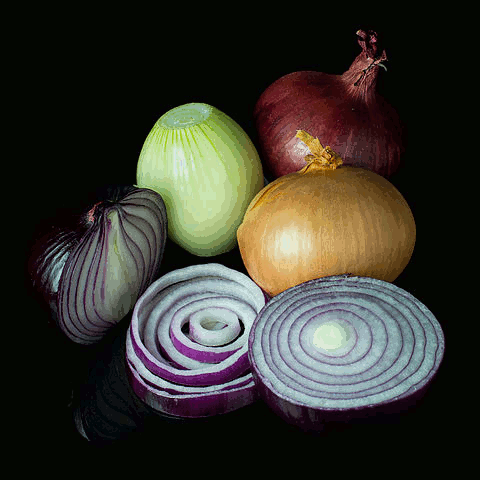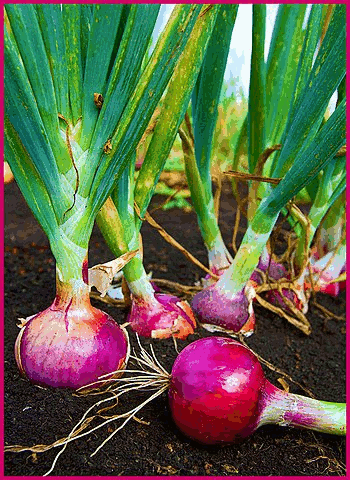Onion
 Common Names: Onion, bulb onion, globe onion
Common Names: Onion, bulb onion, globe onion
Scientific Name: Allium cepa
Climate: Cold and moderate
Plant Description: The onion is a herbaceous biennial plant, famous for its edible bulb. It produces stalks, which do not have leaves, where the green or white flowers are produced. The flowers produce clusters of small balck seeds. It can grow to heights between 75 and 180 cm. The elongated, pointed leaves grow from the bulb. The bulbs vary greatly in size, shape, and colour. It has a distinctive pungent smell which comes from its oil, rich in sulphur, which makes us cry.
Cultivation: Onions are grown from seed, planted directly in the field, but can also be grown from bulbs or transplants. It can adapt to a wide range of growing conditions. They are a cold season crop and resistant to frost. Onions are planted in early spring and harvested in late summer or autumn.
Onions should be planted about 12 cm apart with a distance of about 40 cm between rows. Placing mulch between rows will retain moisture and control weeds. If mulch is used, they do not require constant watering. However, onions do require a lot of water. It is important to get the balance right because too much can lead to fungal growth and too little can cause poor bulb growth. They should be irrigated to a depth of about 2.5 cm once a week rather than daily sprinkling. Watering is best done in the early morning. If watered in the evening, the leaves can remain wet overnight resulting in fungal growth.
They grow best in direct sunlight and where there is no shade from other plants. They prefer loose, well-drained soil that is rich in nitrogen. Compost should be added to the soil before planting. To prevent the spread of diseases that commonly affect the onion, they should not be planted in the same place continuously, crop rotation should be used.
Onions usually need about four months to allow full growth and to be ready for harvesting. When you can see that the leaves are weak and begin to fall over, they are generally ready for harvesting about a week later. After picking, they can be left outdoors for a day or two to allow drying. When the neck of the onion has tightened and the outer skin has started to dry, the leaves and roots can be cut off. Storage depends on the type of onion - pungent or mild. Pungent onions are smaller, have thinner rings and make us cry easily. As mentioned before, this is caused by sulphur in the oil and this also prevents rot, so these can be stored for up to a year. Mild onions, which are bigger and have thicker rings must be eaten within a couple of weeks after harvesting.
 Uses: Onions can be eaten raw but are also a popular ingredient for flavoring many different dishes around the world, boiled, fried, and roasted. Onions are high in vitamins C and D, minerals (manganese and sulphur), antioxidants, and low in calories and are therefore known as a nutrient-dense food.
Uses: Onions can be eaten raw but are also a popular ingredient for flavoring many different dishes around the world, boiled, fried, and roasted. Onions are high in vitamins C and D, minerals (manganese and sulphur), antioxidants, and low in calories and are therefore known as a nutrient-dense food.
There are strong indications that onions can help prevent certain types of cancer. Incidence of colorectal cancer was found to be almost 80% lower in people who regularly consumed allium vegetables, such as onions. It has high vitamin C content, which boosts the immune system, collagen production and aids tissue repair. The sulphur contained in onions also assists in building cells. It also acts as a blood thinner, lowering blood pressure and reducing the risk of heart attack.
The onion is also very useful in agroecology. They can be an effective insect repellent, either growing in the field or in a solution with water. Although not recommended for vermiculture, they are a rich source of potassium in compost or mulch.
Pests and Diseases: Although onions are a good insect repellent, they also have their problems. The pests and diseases that affect the onion are the same as those that affect garlic. The main pests are the onion fly, ringworm, weevil and moth. It is also affected by downy mildew and fungi. Fungi can be prevented through good soil management and ensuring the right level of irrigation as explained above.
References:
https://www.britannica.com/plant/onion-plant
https://www.almanac.com/plant/onions
https://www.gardeningknowhow.com/edible/vegetables/onion/onion-water-needs.htm
https://homeguides.sfgate.com/onions-ripe-pick-37220.html
https://www.sciencedaily.com/releases/2019/02/190221095057.htm
https://www.livescience.com/45293-onion-nutrition.html
En español: Cebolla
